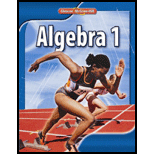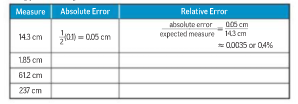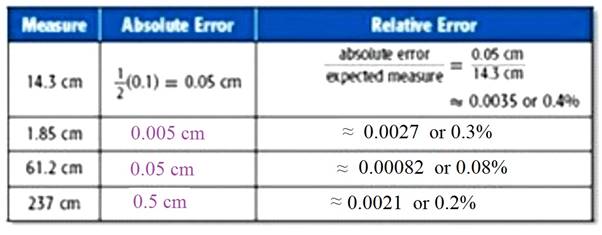
Concept explainers
(a)
Copy and complete the table
(a)
Explanation of Solution
Given:

Concept Used:

(b)
Find the absolute error and range of absolute error.
(b)
Answer to Problem 9QC
Absolute error and range are: 0.05 cm ; 12.75 cm to 12.85 cm
Explanation of Solution
Given:
You measured a length of 12.8 am. Compute the absolute error and then write the range of possible measures.
Concept Used:
The absolute error of a measurement is equal to one half of the unit of measure
Measurement of length is 12.8.
Absolute error: ± 12 · 0.1 = 0.05
Range: 12.80−0.05 = 12.75 to 12.80 + 0.05=12.85
Calculation:
Thus, absolute error and range are: 0.05 cm ; 12.75 cm to 12.85 cm
(c)
Find what precision you would have to measure a length in cm to have an absolute error of less than 0.05 cm.
(c)
Answer to Problem 9QC
To the nearest hundredth place
Explanation of Solution
Given:
To what precision would you have to measure a length in cm to have an absolute error of less than 0.05 cm?
Concept Used:
The absolute error of a measurement is equal to one half of the unit of measure
If the absolute error of loss is 0.05 cm, then the error is to the nearest hundredth place.
Calculation:
Thus, to the nearest hundredth place
(d)
Find the relative error of the volume of the box.
(d)
Answer to Problem 9QC
The relative errors: 0.0077 + 0.0069 + 0.00049 = 0.01509 ≈ 0.015 cm
Explanation of Solution
Given:
To find the relative error of an area or volume calculation, add the relative errors of each linear measure. If the measures of the sides of a rectangular box are 6.5 cm, 7.2 cm and 10.25 cm, what is the relative error of the volume of the box?
Concept Used:
The absolute error of a measurement is equal to one half of the unit of measure and the relative error is of a measure is the ratio of the absolute error to the expected measure.
Calculation:
| Measure | Absolute error | Relative error |
| 6.5 cm | 0.05 cm | absolute errorexpected measurement = 0.05 cm6.5 cm ≈ 0.0077 |
| 7.2 cm | 0.05 cm | absolute errorexpected measurement = 0.05 cm7.2 cm ≈ 0.0069 |
| 10.25cm | 0.005 cm | absolute errorexpected measurement = 0.05 cm10.25 cm ≈ 0.00049 |
Add the relative errors: 0.0077 + 0.0069 + 0.00049 = 0.01509 ≈ 0.015 cm
Thus, the relative errors: 0.0077 + 0.0069 + 0.00049 = 0.01509 ≈ 0.015 cm
Chapter 6 Solutions
Algebra 1
Additional Math Textbook Solutions
Basic Business Statistics, Student Value Edition
Elementary Statistics (13th Edition)
Pre-Algebra Student Edition
Calculus: Early Transcendentals (2nd Edition)
University Calculus: Early Transcendentals (4th Edition)
Algebra and Trigonometry (6th Edition)
- 7) Solve the given system using the Gaussian Elimination process. (5x-4y = 34 (2x - 2y = 14arrow_forward33 (a) (b) Let A(t) = = et 0 0 0 cos(t) sin(t) 0-sin(t) cos(t)) For any fixed tЄR, find det(A(t)). Show that the matrix A(t) is invertible for any tЄ R, and find the inverse (A(t))¹.arrow_forwardUse the infinite geometric sum to convert .258 (the 58 is recurring, so there is a bar over it) to a ratio of two integers. Please go over the full problem, specifying how you found r. Thank you.arrow_forward
- H.w: Find the Eigen vectors for the largest Eigen value of the system X1+ +2x3=0 3x1-2x2+x3=0 4x1+ +3x3=0arrow_forwardneed help with 5 and 6 pleasearrow_forward1) Given matrix A below, answer the following questions: a) What is the order of the matrix? b) What is the element a13? c) What is the element a₁₁? 4 -1arrow_forward
- [25 points] Given the vector let v = ER² and the collection of vectors ε = E-{)·()}-{☹) (9)} = {(A)·(9)}· B: = and C = · {(6)·(})}· answer the following question. (a) (b) (c) (d) (e) verify Verify is a basis for R² and find the coordinate [] of under ε. Verify B is a basis for R2 and find the coordinate []B of ʊ Verify C is a basis for R2 and find the coordinate []c of under ε. under ε. Find the change-of-basis matrix [I]+B from basis B to basis ε, and EE+BUB Find the change-of-basis matrix [I]B+ε from basis Ɛ to basis B, and verify [U]B= [] B+EVEarrow_forwardExplain the following terms | (a) linear span (b) dimension of vector space (c) linearly independent (d) linearly dependent (e) rank of matrix Aarrow_forward3. Let u = 3/5 √ = and = -4/5 -() Define V span{ū, }. (a) (b) (c) Show that {u, } is orthonormal and forms a basis for V. Explicitly compute Projy w. Explicitly give a non-zero vector in V+.arrow_forward
- Is 1.1 0.65 -3.4 0.23 0.4 -0.44 a basis for R3? You must explain your answer 0arrow_forwardFind the values of x and y in the following scalar multiplication. 8 2 x 1 3 || y = 9 LY_ Show Calculatorarrow_forwardA professor gives two types of quizzes, objective and recall. He plans to give at least 15 quizzes this quarter. The student preparation time for an objective quiz is 15 minutes and for a recall quiz 30 minutes. The professor would like a student to spend at least 5 hours total (300 minutes) preparing for these quizzes. It takes the professor 1 minute to grade an objective quiz, and 1.5 minutes to grade a recall type quiz. How many of each type of quiz should the professor give in order to minimize his grading time (why still meeting the other requirements outlined)?arrow_forward
 Algebra and Trigonometry (6th Edition)AlgebraISBN:9780134463216Author:Robert F. BlitzerPublisher:PEARSON
Algebra and Trigonometry (6th Edition)AlgebraISBN:9780134463216Author:Robert F. BlitzerPublisher:PEARSON Contemporary Abstract AlgebraAlgebraISBN:9781305657960Author:Joseph GallianPublisher:Cengage Learning
Contemporary Abstract AlgebraAlgebraISBN:9781305657960Author:Joseph GallianPublisher:Cengage Learning Linear Algebra: A Modern IntroductionAlgebraISBN:9781285463247Author:David PoolePublisher:Cengage Learning
Linear Algebra: A Modern IntroductionAlgebraISBN:9781285463247Author:David PoolePublisher:Cengage Learning Algebra And Trigonometry (11th Edition)AlgebraISBN:9780135163078Author:Michael SullivanPublisher:PEARSON
Algebra And Trigonometry (11th Edition)AlgebraISBN:9780135163078Author:Michael SullivanPublisher:PEARSON Introduction to Linear Algebra, Fifth EditionAlgebraISBN:9780980232776Author:Gilbert StrangPublisher:Wellesley-Cambridge Press
Introduction to Linear Algebra, Fifth EditionAlgebraISBN:9780980232776Author:Gilbert StrangPublisher:Wellesley-Cambridge Press College Algebra (Collegiate Math)AlgebraISBN:9780077836344Author:Julie Miller, Donna GerkenPublisher:McGraw-Hill Education
College Algebra (Collegiate Math)AlgebraISBN:9780077836344Author:Julie Miller, Donna GerkenPublisher:McGraw-Hill Education





